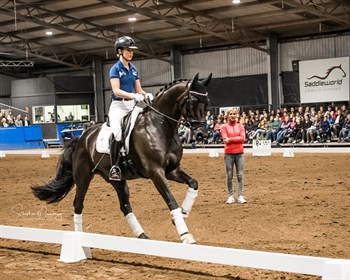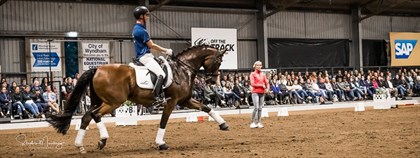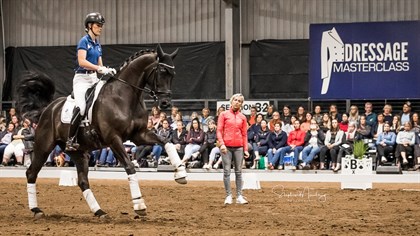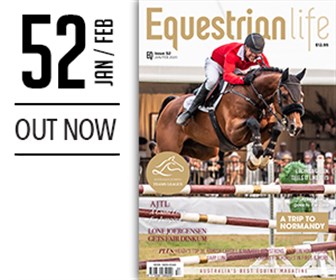|

|

Robbie McKinnon and Silmarillion E in the Small Tour class.
© Stephen Mowbray
After the break the Small Tour horses came in: Robbie McKinnon and Silmarillion E, and Campbell Baxter with Heatherton Park Rapscallion.
Of course, the first exercise Robbie is asked to do is walk, trot, walk. With this Advanced horse, there is more emphasis on the balance. The horse must remain in an uphill balance. Half halt, balance, consistent outside rein.
Campbell and Rapscallion seem a little over awed by the big atmosphere and the crowd. The horse is flamboyant but not connected. Ingrid says, “Oh, he is so ambitious.”
Campbell is reminded to let go of the curb rein. “Easy trotting, not passage.” Rather than use the reins to slow him down, Ingrid gets Campbell to make him softer by bending him. First shoulder in on the circle, then travers on the circle. Then travers left along the long side to E, change the rein with two 1/2 10 metre circles across X, and travers right.
“Sit on your inside seat bone, keep the weight in the direction that you are going. Not too much crossing, more flexion.” Quite quickly the exercise moves on to a long, forwards half pass. Campbell struggles to keep it as forwards as Ingrid wants. She only wants him to go to the centreline.
When Ingrid goes to canter later in the lesson we see why she spends so much time making sure that the horse understands the line, half pass to the centerline, as this is where she is going to put the pirouette. Less sideways. Not picky, precise.
Ingrid suggests he try to do the half pass in Medium trot to facilitate the forwards movement. Start by riding deep into the corners, inside rein and leg bend the horse, and then start the half pass with a few steps of shoulder in before you go sideways. Allow the half pass to be in Medium trot. “If he is ambitious, allow him to work.”

Campbell Baxter with Heatherton Park Rapscallion.
© Stephen Mowbray
Then she takes his stirrups away. “I ride a lot without stirrups, when I want to feel the horse,” she says. “Hold him just with the leg. Heel down, and keep your calf on him all the time and he will be in less doubt. Ask every stride to jump up in front.”
Ingrid asks for the transitions within the pace. Longer strides, small circle. Shoulder in out of the circle along the long side. The circle must be round. Clearly this is becoming preparation for the pirouettes. The horse answers with a more supple collected canter (collect by sinking into the saddle) and of course the exercise finishes with medium cantor along the long side. Walk. Reward.
Robbie continues the sequence of exercises for the pirouettes. Canter a small circle. Push the quarters in to ride travers on the circle to make the circle smaller, and then make the circle bigger with shoulder in. Repeat and step by step, progressively, until the horse can do a 5 metre circle. Then ride forwards in medium canter before asking for the half pass. There is that lesson plan again. Collect and then go forwards, collect again. The canter half pass is from the corner to the centre line.

Robbie McKinnon and Silmarillion E in the Small Tour class.
© Stephen Mowbray
Campbell picks it up again. Ride deep into the corners (more snaffle less curb). Shoulder in the first steps into the left half pass; half pass to the centreline; ride straight up the centre line but keep the bending from the half pass by doing shoulder in along the centreline; and then EASY turning, weight on the inside seat bone, think a little like travers in the turning but shoulder in as you come out up the centre line. Ingrid emphasises the EASY turning, just think of an easy turn, not making a pirouette. And of course, the result is soft and balanced.
This lesson was a lovely demonstration of systematic, progressive development of the collection. The early exercises must be ridden with precision so that the horse is familiar with the lines and understands the requirements, while building his balance. Always the collection, followed by going forward, and no exercise repeated so often that it becomes dull.
READ THE LATEST NEWS ARTICLES HERE

|

|

